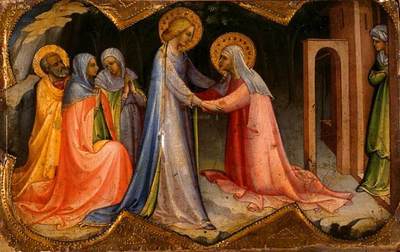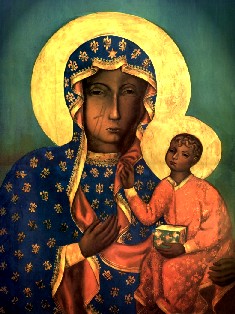 The Church has offered us a “Marian sandwich.” Let me explain. This week we are honoring the Mother of God with three distinct memorials: The Nativity of Mary (Sept. 8) and Our Lady of Sorrows (Sept 15) and today the commemoration of the Holy Name of Mary. In liturgical history this feast has been observed on various days before settling on this day. The feast was reintroduced to our Roman Missal by Pope John Paul II.
The Church has offered us a “Marian sandwich.” Let me explain. This week we are honoring the Mother of God with three distinct memorials: The Nativity of Mary (Sept. 8) and Our Lady of Sorrows (Sept 15) and today the commemoration of the Holy Name of Mary. In liturgical history this feast has been observed on various days before settling on this day. The feast was reintroduced to our Roman Missal by Pope John Paul II.
Tag: Blessed Virgin Mary
Nativity of the Blessed Virgin Mary
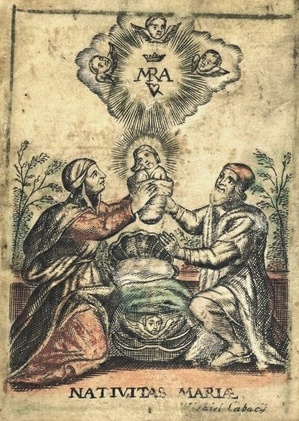 Let us celebrate with joy the Nativity of the Blessed Virgin Mary, for from her arose the sun of justice, Christ our God. (antiphon)
Let us celebrate with joy the Nativity of the Blessed Virgin Mary, for from her arose the sun of justice, Christ our God. (antiphon)
Impart to your servants, we pray, O Lord, the gift of heavenly grace, that the feast of the Nativity of the Blessed Virgin may bring deeper peace to those for whom the birth of her Son was the dawning of salvation.
Several things to pray for today,
- the Most Rev. Edoardo Aldo Cerrrato, CO, on the day of his episcopal ordination in Rome;
- the Cistercian Order;
- those who professed vows today;
- the Benedictines of Saint Mary’s Monastery (Petersham, MA);
- Archbishop Charles Chaput, OFM, Cap, on the first anniversary of being the archbishop of Philadelphia;
- Michael Maggiore who is healing.
Keeping in mind what Saint Thomas of Villanova reflected upon for today’s feast,
“What joy, what happiness there is in heaven! The shoot for the root of Jesse, sown so long ago in the patriarchs, has today sprung up and began to grow, and will bear a Flower which is destined to heal the world; a Flower whose scent revives the dead, whose taste heals the sick, whose beauty delights the angels; a Flower both white and red, which the angels long to see.”
Father Francis Weiser, S.J., in his The Holyday Book writes about today’s feast thus:
On Our Lady’s birthday the Church celebrates the first dawning of redemption with the appearance in the world of the Saviour’s mother, Mary.
The Blessed Virgin occupies a unique place in the history of salvation, and she has the highest mission ever commended to any creature. We rejoice that the Mother of God is our Mother, too.
Let us often call upon the Blessed Virgin as “Cause of our joy,” one of the most beautiful titles in her litany.
Since September 8 marks the end of summer and beginning of fall, this day has many thanksgiving celebrations and customs attached to it. In the Old Roman Ritual there is a blessing of the summer harvest and fall planting seeds for this day.
The winegrowers in France called this feast “Our Lady of the Grape Harvest”. The best grapes are brought to the local church to be blessed and then some bunches are attached to hands of the statue of Mary. A festive meal which includes the new grapes is part of this day.
In the Alps section of Austria this day is “Drive-Down Day” during which the cattle and sheep are led from their summer pastures in the slopes and brought to their winter quarters in the valleys.
This was usually a large caravan, with all the finery, decorations, and festivity. In some parts of Austria, milk from this day and all the leftover food are given to the poor in honor of Our Lady’s Nativity.
The 2010 post which includes a portion of a homily Saint Andrew of Crete is here.
Queenship of Mary
We, too,
approach thee to-day, O Queen; and again, I say, O Queen, O Virgin Mother of
God, staying our souls with our trust in thee, as with a strong anchor. Lifting
up mind, soul and body, and all ourselves to thee, rejoicing in psalms and
hymns and spiritual canticles, we reach through thee One who is beyond our
reach on account of His Majesty. (Saint John of Damascus)
… devotion to Our Lady is an important element
in our spiritual lives. In our prayer, let us not neglect to turn trustfully to
her. Mary will not neglect to intercede for us next to her Son. In looking to
her, let us imitate her faith, her complete availability to God’s plan of love,
her generous welcoming of Jesus. Let us learn to live by Mary. Mary is the
Queen of heaven who is close to God, but she is also the Mother who is close to
each one of us, who loves us and who listens to our voice.
Pope Benedict XVI
Queenship of Mary, 2012
Assumption of the Blessed Virgin Mary
 “those He justified, He also glorified” (Rom
“those He justified, He also glorified” (Rom
8:30)
of Mary from this world to the next. The Eastern Christians call today’s feast
the “Dormition,” the falling asleep of the Theotokos and the assumption to
heaven. In the West, we refer to this feast as the Assumption. That Mary,
without decay of the human, was called to heaven body and soul, by God.
Saint Mary of the Angels & The Portiuncula Indulgence
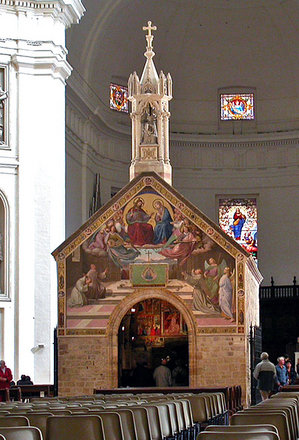 The spiritual tradition of the Franciscans is connecting the with the good work of the sainted founder, Saint Francis, who as you know, fixed three chapels: the third was called the Portiuncula (the Little Portion), dedicated to Saint Mary of the Angels. As you can see, the chapel sits in a large basilica in Assisi. The friars have been at the Portiuncula since early thirteen century. Saint Clare made her vows following Palm Sunday in 1212 and where Francis died on 3 October 1226.
The spiritual tradition of the Franciscans is connecting the with the good work of the sainted founder, Saint Francis, who as you know, fixed three chapels: the third was called the Portiuncula (the Little Portion), dedicated to Saint Mary of the Angels. As you can see, the chapel sits in a large basilica in Assisi. The friars have been at the Portiuncula since early thirteen century. Saint Clare made her vows following Palm Sunday in 1212 and where Francis died on 3 October 1226.
For centuries the Church, at the request of Francis, has attached a spiritual favor in the form of indulgence, a grant remission of sins to all who came there. It used to be given only at the Portiuncula but now the privilege extends beyond the Portiuncula especially those administered by Franciscans, throughout the world, to others churches as well.
The Church teaches that a plenary indulgence is a powerful tool for works of mercy and weapon in the living of the Christian life, that is, in our spiritual warfare. A plenary indulgence is the remission of the effects of sin, through the merits of Jesus Christ and the saints, through the Church, of all temporal punishment due to sin already forgiven through the reception of the sacrament of Confession.
Immaculate Heart of the Blessed Virgin Mary
The Visitation of Mary to Elizabeth
The Word of God is not a literary expression, but is the indication of an event, it is always a fact: the Word of God is Christ. His word starts from the promise of an event. The figure of the Virgin is completely filled with memory, the word of her people, stretching completely toward the meaning of these events (the Angel’s announcement, Elizabeth’s greeting). This is why Elizabeth used the highest form of address: ‘Blessed is she who believed in the fulfillment of the Word of the Lord.’
Monsignor Luigi Giussani
The Golden Rose given to Our Lady of Charity of Cobre, Cuba
 A rose among thorns. Well, almost. Man and woman
A rose among thorns. Well, almost. Man and woman
always want to give an expression of love and affection to another. In the
course of history you will notice the gifts of love’s sentiment and reality
given to God, the Blessed Virgin Mary and the saints. Visit a shrine where
healings are reported and you’ll notice tokens of gratitude: lockets, flowers, chalices, artwork, and the like. One beautiful gift of
love was given by Pope Benedict Monday evening to the Virgen de la Caridad de
Cobre in Cuba: a golden rose. The papal gift of a golden rose dates back to the
middle ages when a pope held a golden rose in a procession on Laetare Sunday,
the fourth Sunday of Lent. It was Pope Eugene III who called the rose a sign of
Christ’s passion: the gold symbolizing the resurrection and the thorns the
suffering.
expanding the meaning: a personal honor and a reminder: do not forget the
responsibilities and duties that come with being a Christian. Beyond the human
honor given to royalty, the rose was given to abbeys and sanctuaries of the
Virgin Mary. Pope John Paul II gave a few these roses to shrines and Pope
Benedict XVI is fond of the custom and so he’s given roses to Altötting, Mariazell,
Fatima, Aparecida, USA and now to Cuba.
The Annunciation of the Lord
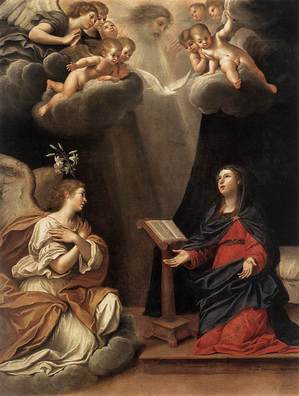 The mystery of the annunciation to Mary is not just a
The mystery of the annunciation to Mary is not just a
mystery of silence. It is above and beyond all that a mystery of grace.
feel compelled to ask ourselves: Why did Christ really want to be born of a
virgin? It was certainly possible for him to have been born of a normal
marriage. That would not have affected his divine Sonship, which was not
dependent on his virgin birth and could equally well have been combined with
another kind of birth. There is no question here of a downgrading of marriage
or of the marriage relationship; nor is it a question of better safeguarding
the divine Sonship. Why then?
and see that the mystery of Mary is prepared for at every important stage in
salvation history. It begins with Sarah, the mother of Isaac, who had been
barren, but when she was well on in years and had lost the power of giving life,
became, by the power of God, the mother of Isaac and so of the chosen people.
process continues with Anna, the mother of Samuel, who was likewise barren, but
eventually gave birth; with the mother of Samson, or again with Elizabeth, the
mother of John the Baptizer. The meaning of all these events is the same: that
salvation comes, not from human beings and their powers, but solely from
God–from an act of his grace.
for Every Day of the Year (1992), 99-100.
The authentic Church is an extension of Good Samaritan today
At Vespers
(evening prayer) with the gathered bishops of Latin America at the
Cathedral-Basilica of Our Lady of Light, (Leon, Guanajuato, Mexico) this evening the Holy
Father address the following homily. His thoughts turn our attention to a
deeper fidelity in belonging to Christ, being true in communion with others,
rooted and ground in Love. The homily is terrific, he hits on some real significant issues that concern the Catholic Faith and the promotion of Justice. But I can’t help thinking that the Pope is treating this pastoral visit as a giant Ad limina.
It gives me great joy to be able to pray with all of
you in this Basilica-Cathedral of León, dedicated to our Lady of Light. In the
lovely painting venerated in this basilica, the Blessed Virgin holds her Son in
one hand with immense tenderness while extending her other hand to succour
sinners. This is how the Church in every age sees Mary. We praise her for
giving us the Redeemer and we put our trust in her as the Mother whom her
divine Son bequeathed to us from the Cross. For this reason, we invoke her
frequently as “our hope” because she has shown us Jesus and passed down to us
the great things which God constantly does for humanity. She does so simply, as
a mother teaches her children at home.
A decisive sign of these great things is
given to us in the reading just proclaimed at these Vespers. The people of
Jerusalem and their leaders did not acknowledge Christ, yet, by condemning him
to death, they fulfilled the words of the prophets (cf. Acts 13:27). Human evil
and ignorance simply cannot thwart the divine plan of salvation and redemption.
Evil is simply incapable of that.
Continue reading The authentic Church is an extension of Good Samaritan today



